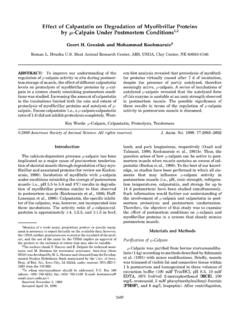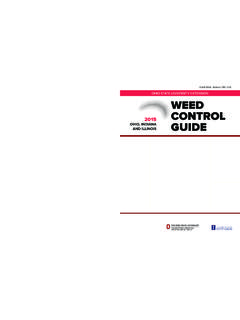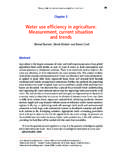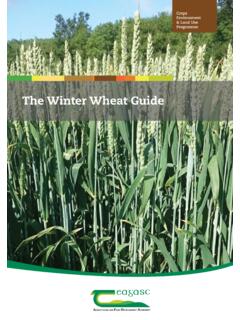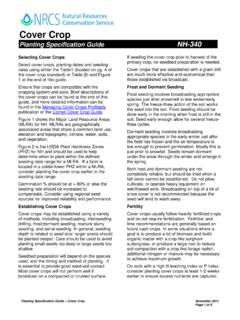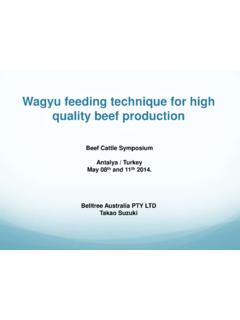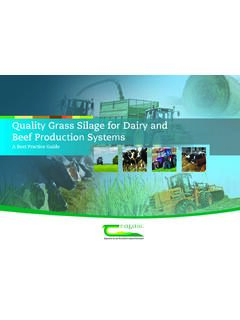Transcription of Introduction to Plant Disease - USDA ARS
1 Introduction to Plant Disease Review of Principles What is a Disease ? Any abnormal condition that damages a Plant and reduces its productivity or usefulness to man. Two types of diseases. 1. Non-infectious (abiotic) Not caused by a living parasitic organism; usually an environmental factor 2. Infectious (biotic) Caused by a living parasitic organism What is a non-infectious Disease ? -- Diseases caused by some environmental factor that produces an abnormal Plant , abnormal appearance. Examples: Nutrition. Excess or deficiency N deficiency, yellowing Moisture.
2 Deficient or excessive water. Deficiency, stunting Excessive, lack of oxygen to roots. What is a non-infectious Disease ? More examples: Temperature. Cold or hot. Frost damage; heat sterility in small grains. Meteorological conditions. Sun, sunscald. Heat canker caused by high temperature Toxic chemicals. Ozone injury; Salt injury. What is an infectious Disease ? Infectious (biotic) diseases are caused by organisms that attack plants and get their nutrition from them. Host - the Plant attacked by a parasite. Pathogen - the organism causing the Disease .
3 Fungi; Bacteria; Viruses; Mycoplasmas; Nematodes Terms Parasite - an organism living on or in another living organism and obtaining food from another organism. Obligate parasite - always a parasite; can only live on or in another organism. Parasites causing leaf rust, stem rust of cereals. Facultative parasite - having the ability to be a parasite; can live on living or non-living host. Parasites causing leaf spots of cereals. Terms Symptoms - expressions of Plant diseases; visible abnormalities; tissue death; stunting; abnormal color Necrotic - dead and discolored.
4 Chlorosis - yellowing of normally green tissue Signs - presence of pathogen or its parts fungal structures; bacterial ooze Terms Inoculum - pathogen or its parts that can cause infection. That portion of the pathogen brought into contact with the host. Spores; mycelial fragments or structures Predispose - weaken plants; increase effects of infectious diseases. Temperature, moisture, wind, light, soil pH, nutrition, herbicides Three factors needed to produce a Disease : Pathogen Host Environment If any of the 3 factors is missing Disease will not develop.
5 Host Pathogen Environment Plant Disease Triangle Disease Favorable Environment Pathogen Host Susceptibility Virulent pathogen Fungi, Bacteria, Viruses, Nematodes, Mycoplasmas and Spiroplasmas Air temperature Soil moisture Relative humidity Soil temperature Soil fertility Stand density Rainfall Soil type and soil pH Planting time Pathogen The organism causing the Disease . Fungus, fungi - organisms which lack chlorophyll and range in form from a single cell to a body mass of branched filamentous hyphae. Includes the yeasts, molds, smuts, and mushrooms.
6 Hyphae, mycelium, thread-like filaments. Fruiting bodies, structures containing spores; can be signs on the host. Spores, reproductive unit; seeds; Rusts, smuts, leafspots, powdery mildew Pathogen Bacterium, bacteria - microscopic single-celled organisms; reproduction by division of body into two parts. Bacterial blights, wilts, fireblight Viruses - submicroscopic particles of RNA with a protein coat; obligate parasite. Wheat streak mosaic, cucumber mosaic, potato viruses Pathogen Nematodes - generally microscopic eelworms or roundworms Usually not a serious problem in North Dakota Carriers or vectors of viruses, fungi, or bacteria.
7 Mycoplasmas - microorganisms with no cell wall, no definite shape. Aster yellows (purple top in potato and tomato). Environmental Factors Once Disease established, local environment determines rate of Disease development Disease severity can differ from site to site or be similar in region Rainfall Risk of Disease greatest with highest rainfall levels Dry conditions or intermittent wet/dry can limit Disease development Temperature can influence Disease A host, pathogen, and favorable environment are required for the development of a Plant Disease .
8 Plant Disease TrianglePathogenVirulent pathogen:Fungi, Bacteria,Viruses,Nematodes,Mycoplasmas andSpiroplasmasHostSusceptible-crop-cult ivarFavorable EnvironmentAir temperatureSoil fertilityRainfallSoil temperatureSoil typeRelative humiditySoil pHSoil moistureDiseasePlant Disease Triangle Knowledge of Crop Diseases Important for developing management tactics Major crop diseases on crop grown? Host range of major Plant pathogens? Major crop diseases in your area? Records of Crop Diseases Important for developing management tactics Local farm and field history?
9 Disease problems in past? Crop sequence in fields? No. of years since last host crop? Disease impact in last host crop? Field scouting/In-crop inspections Diseases present; Disease impact Measurement of Disease Incidence of Disease - proportion of host units that show symptoms. Severity of Disease - proportion of area or amount of Plant tissue that is diseased; percentage of Plant destroyed by Disease . Yield loss - proportion of yield that grower will not harvest because of Disease . General Disease cycle Monocyclic or single cycle pathogens - one Disease cycle in one year.
10 Smuts Polycyclic or multi-cycle pathogens - more than one cycle per year; secondary inoculum, secondary infection. Downy mildews, powdery mildews, grain rusts, leaf spots Pathogen Factor How are pathogens transmitted? Air-borne, long distance (rusts) Air-borne, short distance Seed-borne (smuts) Insect transmitted (WSMV) How do pathogens survive? Stubble or residue borne Seed-borne Soil-borne Dissemination (spread) of pathogens Wind - Air-borne fungal spores Wheat leaf rust, stem rust Insects - Carriers of viruses Aphids - barley yellow dwarf Water - Carry or splash spores People - Carry over long distances contaminated farm equipment Animals and birds Survival of pathogens Soil Resistant structures of pathogens, sclerotia Seed and Plant parts Pathogens survive in infected seed and Plant parts Insects Bacterial wilt pathogen in cucumber beetles Mild climates Basic methods of Plant Disease management.




